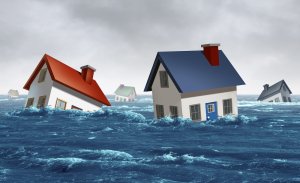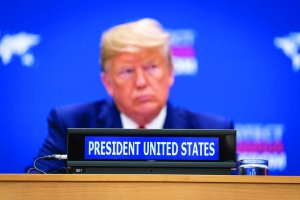Do we really grasp the danger of pandemics and the critical need to prepare for and protect ourselves from their massive impacts? Our current response efforts say no.
Dr. Phillip Alvelda warns that when not properly monitored and addressed — as with the ongoing COVID situation — pandemics have the potential to cripple entire generations before we realize what hit us. They pose a severe global threat to humanity: at this very minute, you are far more likely to be disabled by COVID than by any nuclear event.
Alvelda, a former program manager in DARPA’s Biological Technologies Office, which pioneered the synthetic biology industry and mRNA vaccine technology, founded Medio Labs, a major COVID diagnostic testing company. He has taken to task governments and health agencies for their past and continuing failure to adequately protect the public from COVID, including issues related to Long COVID and risks of reinfection, as well as their neglect of crucial mitigation strategies and tracking systems. These shortcomings, he warns, leave us unnecessarily vulnerable to potential future pandemics, a concern heightened by the creeping prevalence of the H5N1 bird flu across dairy farm cattle.
In the following conversation with the Institute of New Economic Thinking’s Lynn Parramore, Alvelda dives into what most worries him and outlines actionable steps forward, including the need for air quality laws and holding those who maintain buildings accountable if people get sick.
Lynn Parramore: Let’s start out with the overall COVID situation right now. Where are we?
Phillip Alvelda: Recently, speaking in Harrisburg, PA on the campaign trail, President Biden stated, “I’ll be blunt. I ended the pandemic.” It reminds me of George Bush declaring victory over Iraq with his infamous “mission accomplished” speech on the aircraft carrier.
Unfortunately, despite what we hear from many of our leaders, the pandemic continues. We have wave after wave of new variants. We are in the middle of a summer surge, and it’s growing in most states – this is even highlighted now by the CDC. COVID is still a major cause of death and disability around the world.
That’s the reality, but the mainstream media is not picking this up – even as we accumulate more evidence that people are dropping out of the labor market because of long-term health disabilities due to Long COVID.
LP: It’s ironic that Biden declared this right as Vice President Kamala Harris’s husband contracted COVID – and then got reinfected himself.
PA: It is! President Biden has already had COVID how many times? At least twice in the past that I know of. And the President has just announced that he tested positive yet again. This is a really serious concern given that we now know that accelerated mental decline is a common sequela of COVID and is increasingly likely with each subsequent infection. For a third infection, his chances of Long COVID are 25%-35%, no matter how mild the acute symptoms are. There’s a new report outlining these issues in The Atlantic, which references a study by the U.S. Social Security Administration on the long-term health consequences of COVID, including for the elderly.
LP: As you’ve noted, the growing cumulative risk of each reinfection underscores why our leaders must avoid getting COVID over and over. Speaking of risks, I was just reading that scientists are now asking if Covid could be linked to rare and aggressive forms of cancer that have been popping up.
PA: Yes, and it’s not just that serious illnesses like this are popping up: they’re popping up in people 10-20 years earlier than they normally do. Whether you visit a cardiac, diabetes, Alzheimer’s, or cognitive therapy practice, medical workers report that since 2019, they’ve been seeing diseases that typically affect those over 50 now afflicting individuals in their 20s and 30s. It’s a wholly new situation. COVID can affect various organs in the body and weaken the immune system – and the damage can linger. Long COVID can affect every organ system in the body. And the public health agencies—where are they on all this? They absolutely know all of this but maintain a policy of silence and minimization, even as the overall toll grows.
LP: As public health agencies drop the ball, it’s getting increasingly hard for people to find reliable, up-to-date information on what’s going on. Where can they go?
PA: The People’s CDC is distributing good information. It’s a separate organization of independent scientists who have been involved in some capacity or another in the pandemic response. Many of them, having been frustrated at being muzzled within federal agencies, have left so that they could speak independently. They have been publishing regular reports that compile what data is available or, in the absence of data, using what data they do have to infer what’s really going on. Unfortunately, what they can distribute is severely limited by the fact that testing has been severely curtailed.
For example, we don’t have very good case-by-case count data anymore because that’s been discontinued in most states. But the wastewater measurements that we have remain accurate, and we can also estimate the prevalence of cases from the rate of test positivity. Companies like Walgreens and some hospital groups track the tests that they give and what percentage turn out to be positive. It turns out that’s the proxy for how prevalent the cases are. It’s not quite as accurate what we’d have if there was much more testing, but it’s the next best thing.
LP: What are the latest developments on bird flu?
PA: There has not been a lot of new data published on bird flu, and I think the reality is that the testing is so sparse that it’s very difficult to get an idea of the extent of it. We do know that 12 or so states have reported ongoing infection of dairy cattle. As you might imagine, the farmers have resisted testing because they don’t want their milk pulled from the market. It’s concerning that one of the scientific reports on the bird flu, an NIH study, showed that a small amount can survive the normal pasteurization process. We can detect infectious viruses in the milk even after the process.
What happens going forward really all depends on the virus evolving the ability to infect humans directly and be passed from human to human. We’ve seen a few cases now of humans who work around cows coming up with the bird flu. There are a few other weird things going on that we don’t yet understand, too. We’re detecting bird flu in the wastewater, like in San Francisco, for example, and there are no dairy farms in San Francisco. Where’s it coming from?
LP: Research on bird flu mutations indicates that the virus could potentially spread to humans by breathing. A report by scientists at the University of Wisconsin-Madison found that viral samples taken from cows were able to attach to receptors found on cells in the human respiratory tract. How concerning is that?
PA: It is concerning. A number of similar results are starting to pop up here and there. It may be an inevitable trend. One of the challenges is testing. There should be way more testing, not just of people, but cattle. It’s part and parcel of the food chain. The more cows you have that are infected, the more dangerous the situation becomes. It’s kind of like each infected cow is a reservoir of experimentation for the virus, trying trillions of different ways to mutate that may or may not infect a human. We have humans working very closely with the cattle to produce milk, so it could be a ready-made pandemic in the waiting.
Some people in the scientific community have said pretty candidly it’s not a question of whether we’re going to have more problems with the bird flu virus, but when.
Reuters reported Seth Berkley, a widely respected epidemiologist, telling Stat News that he is shocked to watch the ineptitude of how public officials in the U.S. are handling the situation.
LP: How bad is this for the people working around the animals?
PA: It’s not good. The guidance now for the workers in these dairy farms is full Biosafety Level 3, or BSL-3, which means environment suits with goggles and face shields and all that. That’s what it takes to protect yourself against this disease.
LP: Are farm laborers wearing that kind of protective gear? I’m trying to imagine it in the summer heat.
PA: No, I don’t think they are. So we’re seeing more reports of farm hands coming down with the bird flu and conjunctivitis.
LP: You’ve long expressed concern about the failed leadership at organizations like the World Health Organization [WHO] and the CDC in their handling of the COVID pandemic. What has been the most serious failure so far?
PA: The most devastating failure was the WHO’s willful decision to deny the airborne transmission of the coronavirus.
LP: I recall the now-infamous tweet, where the CDC stated that it was a fact that COVID isn’t airborne.
PA: Yes. And it wasn’t just the tweet. It was an ongoing campaign over two years — while a growing number of scientists became increasingly vocal about its definitively demonstrated airborne nature, and not just scientists in the West. It’s interesting to look at the countries that were most successful in dealing with the pandemic and protecting public health and their economies. They were the countries that identified and recognized the airborne transmission early on. They adjusted policies around indoor air quality and improved mask standards to include the wearing of respirator masks, not just surgical masks, in hospitals.
I believe there’s been an element of subtle racism in the American response, in terms of suggesting that only Asian countries were socially compliant and willing to mask up. But the critical point is that countries like Korea, Japan, Taiwan, and China swiftly acknowledged the airborne nature of the virus after the Diamond Princess incident in February 2020.
LP: The Diamond Princess was that ship that got stranded at sea during the early stages of the pandemic after a terrible COVID outbreak.
PA: Yes, and after this event, these countries never dithered or wavered – they maintained consistent policies focused on mitigating an airborne virus from the outset.
And it’s not just about resistance or bias. There’s been stubbornness and willful deception. Internal scientists within the WHO and the CDC were aware of COVID’s airborne nature and telling the agencies how to prevent transmission. These agencies were fixing their own internal air handling, and making sure places like the White House had air quality upgrades. Meanwhile, public guidance from both the WHO and the CDC continued to emphasize hand-washing and droplet precautions over airborne measures, despite mounting evidence.
Unfortunately, this is still true today. Even though we have new research indicating that airborne transmission of COVID is exponentially more likely than transmission through droplets or surfaces, we still have both the WHO and the CDC prioritizing things like hand washing. On its list of official recommendations for protecting yourself against the virus, the CDC website still places “good hygiene” such as hand washing before air quality, which is far more important.
LP: Pretty astonishing given what we now know.
PA: It’s a failure in public health.
LP: Let’s talk about masking. I see some people wearing masks as COVID protection, but a lot of times it’s a surgical mask, and one hanging loose around the nose, at that. What do people need to know about masks as we’re in this summer surge?
PA: A surgical mask or a cloth mask is better than nothing. But it’s a super easy switch to say, “Hey, if you’re willing to wear a cloth mask, why not just get a respirator instead?” A respirator mask, an N95 mask with a good seal over the nose and mouth, doesn’t cost that much money. You don’t wear that many masks. Look, none of the masks is absolutely perfect, but, the better the respirator is, the more it filters out. An N95 mask extends the amount of time that you can be safe in an area where there is coronavirus floating in the air.
LP: So, for example, if I take the subway to work, and somebody on the train is infected, a good mask could protect me long enough for my trip.
PA: That’s right. A good mental model for how these masks either do or don’t work is to think about cigarette smoke. Smoke is an aerosol. It hovers around in a room after you leave, just like COVID aerosols.
LP: If I think of somebody smoking a cigarette on the subway car, it doesn’t matter how far away from that person I am, that cigarette smoke is in the air I’m breathing. And COVID works this way, right?
PA: Right, and given the current infection rates, you need to take precautions. The Pandemic Mitigation Collaborative, originating from Tulane’s pandemic response team and led by Michael Hoerger from Tulane’s School of Medicine, has compiled data showing that, on average, 1 in 73 Canadians and Americans are currently infected with COVID, and hotspots like New York and San Francisco, with higher population and transportation density, have even higher rates and higher risks. So, if you’re in a room or subway car or bus containing 35 or more people, there’s at least a 50/50 chance that at least one of those people is infected.
Even after an infected person walks out of your subway car, the aerosol lingers in the air for some time, just like cigarette smoke. You can extend that analogy to how effective a mask is. If your mask has air gaps around the edges, or even if you use a KN95 with ear loops that don’t really pull it very closely around your face, then the protection is less effective at shielding you from airborne viruses which leak right around the edges. Better than a surgical mask perhaps, but not nearly as good as a proper N95 mask with the dual headbands.
Keep in mind that the surgical mask was never designed to protect against airborne illness. In fact, hospitals actually have protocols that if there is an airborne illness, like say tuberculosis, you wear a respirator. That’s what protects you from airborne illnesses. Unfortunately, when it comes to COVID, the non-scientific public statements from the CDC and the WHO and all the guidance saying that it’s droplets that you need to worry about and not aerosols have given hospitals an out to avoid spending the extra pittance for proper N95 masks or better PPE for their staff and avoid “inconveniencing their patients.” But this decision put all the doctors and nurses and hospital staff at severe risk and ultimately has and is continuing to decimate their ranks with Long COVID sufferers dropping out of the profession. They still persist in using surgical masks. Worse, it led the hospitals to abandon their internal infection control measures resulting in a huge spike in hospital-acquired COVID infections which are showing something like a 5-10% mortality rate. Maskless hospitals are now literally an existential risk for any immune-compromised patient, whether from Long COVID, cancer treatment, or other immune disorders.
Even now, after the CDC has supposedly corrected their guidance that the coronavirus is, in fact airborne. Most hospitals still persist in using surgical masks, and in some states, no masks at all. What happened to their Hippocratic Oaths? Remember, “First do no harm!”
LP: Given your concern about a systemic public health failure, what do you see as the single most critical step in reforming and reinvigorating public health right now?
PA: I think a crucial change that will drive a lot of other positive changes is implementing laws on indoor air quality and establishing liability if it’s not maintained and people get sick as a result.
The CDC’s admission that the virus is airborne — and that infection through the air is much more likely – literally a million times more likely —- compared to transmission via droplets or surfaces — has shifted the landscape of liability for infections. Previously, with droplets and surfaces, there was an emphasis on individual responsibility to wash your hands or to wear something that will shield you from a droplet. Now, with emphasis on indoor air quality and aerosols, the responsibility shifts to whoever maintains the facility for ensuring air quality, like an office that you’re required to work in, or a meat packing plant, or a school that you or a child has to attend. The people running the facility must be responsible for maintaining the air quality – and if they don’t maintain it, let’s start suing them. If we do that, then everyone will start to invest in the necessary upgrades.
LP: What steps are necessary to ensure our offices have excellent air quality?
PA: It’s a minor engineering problem, with a few important parameters. Probably the most important factor is how much fresh air is being pumped into the facility relative to the occupancy.
LP: When you say “pumped in,” I would assume a lot of offices don’t have any air being pumped in at all.
PA: This is one of the grand ironies of the whole LEED certification system for construction [Leadership in Energy and Environmental Design]. It’s supposed to provide a framework for healthy, efficient, and cost-saving green buildings. These energy efficiency standards often involve recirculating air instead of introducing fresh air. The goal is to cool or heat air that has already been somewhat cooled or heated in the previous cycle. This approach yields significant energy savings when you recirculate used air, it so it offers environmental benefits. But it doesn’t offer public health advantages.
So I think some of the indoor air requirements and certifications need to be rejiggered to include protection for public health — and that includes the proportion of fresh air. We need to focus on the air exchange rate, specifically the number of complete air exchanges per hour (CPH). The recommendation is no fewer than six or seven complete air exchanges per hour.
LP: In New York City, where I reside, I’d be curious about the percentage of buildings that actually maintain adequate air exchange controls.
PA: Right now I’d be surprised if it’s five percent. But that’s not the only parameter. CPH is the most important one because it ensures that air is free from high doses of viruses. But there are many offices and buildings like schools that cannot maintain six or seven exchanges for whatever reason. Maybe they’ve got old pipes, old ducts, maybe outdated equipment, or maybe the number of people who use them has grown relative to the original design of the system. There are all kinds of reasons.
Fortunately, another way to get the air exchanges is just to open the windows and use ventilation louvers that help maintain fresh air. For schools, you can actually conduct classes outside when it’s not too hot or cold – but of course in the Florida summer heat or New York winter cold, few want the doors and windows open – which is why you have virus surges in the summer and winter. You might also be dealing with an internal room where opening the windows isn’t an option.
In these cases, you want to make sure that the air handling systems have upgraded filtration. The MERV 13 system, which is great at capturing particles, is the viral filtering standard. But it’s expensive, and we’re talking about a lot of air conditioning systems that need to be upgraded. There’s also an issue in that when you put in some of these denser filters they reduce the airflow. So maybe you need to upgrade the air conditioning to accommodate a bigger duct with a denser filter to make sure that what air does get in is at least filtered.
Of course one of the problems is that a lot of the public schools don’t even have money for textbooks, much less air filters. We have construction, logistics, sourcing, and funding problems in schools that could have been solved already. Again it goes back to the consequence of the CDC focusing on droplets and surface washing. Billions of dollars that were allocated to protect the nation’s schools against COVID were spent on hand sanitizers and surface cleaning and plexiglass and all kinds of bullshit that didn’t have any impact on protecting the kids. Had that money been instead invested in upgrading the air handling and filtration everyone would have been much better off. Misguided communication from the agencies has been a big problem.
There is still an urgent need to address air quality in schools, however. Data from the U.K., for example, shows that in the 2023/24 school year, the rate of student absence due to illness was 40% higher than the pre-pandemic rate — and you can be sure that a large part of that increase is due to COVID. We lack testing and data, but we know that millions of children are likely suffering from Long COVID, as several studies have shown, including a recent JAMA report. The symptoms range from brain fog and mental health problems to cardiac issues.
LP: You’ve emphasized the importance of governments following scientific guidance. I’m curious about places that are trying to do better in that regard. For instance, Spain is looking into setting up a new office for scientific advice aimed at providing expert guidance during crises like pandemics. Is that a step in the right direction?
PA: I do think it’s a step in the right direction. I think one of the great tragedies of American politics for the last 40 years is that we really dealt a death blow to our scientific establishment and its relationship with politics. Time and time again, scientific advice was coming in contrary to political ideologies, so the science was ignored. We’ve seen this on issues like tobacco use, climate action, and pandemic response.
We ended up with a system where the politicians would simply search for some set of scientists that would support their ideology, no matter how fringe, and use them to champion an ideology as a political tool. The idea that there could be a scientific consensus that should drive policy just kind of went away.
We have an issue around non-partisan science and the principle of letting scientific consensus guide policy decisions. If we could return to that we would all be much better off. But our political system purposely abandoned that some time ago to our detriment.
LP: How do we reinvigorate surveillance testing for current and future pandemics?
PA: That’s a great question. I was having a conversation not long ago with my old advisor Tom Knight from MIT, and he pointed out that when the world recognized nuclear bombs and the proliferation of nuclear materials as a global threat, it spurred significant investment in satellite surveillance and detection systems capable of monitoring global activities, including the experimentation with and launch of missiles. That was not a simple endeavor. It was creating an entire global surveillance system from nothing. Hundreds of billions of dollars were invested over decades to build that protective surveillance infrastructure.
LP: Do you believe that the ongoing threat to human health posed by repeated COVID infections and the potential for future pandemics, exacerbated by inadequate responses, is as significant a threat to humanity as the possibility of nuclear warfare?
PA: Well, more people have already died from COVID than from any nuclear explosion by a factor of 150x. I don’t think anyone can reasonably argue that these types of pandemics are not a global threat, and worthy of similar efforts.







